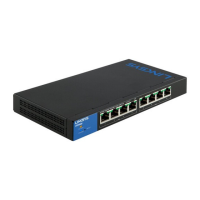10
Table of Contents
Linksys
Chapter 4 System Management
This chapter describes the following topics:
• System Information
• Management Session Timeout
• Time
• SNMP
• Logs
System Information
To enter system information, do the following:
STEP 1 Click Configuration > System Management > System Information.
STEP 2 View or modify the system settings.
• System Description—Displays a description of the device.
• System Location—Enter the location where the device is physically located.
• System Contact—Enter the name of a contact person.
• System Host Name—Select the host name of this device.
• Default—The default host name (System Name) of these switches is
switch123456, where 123456 represents the last three bytes of the device
MAC address in hex format.
• User Defined—Enter the host name. Use only letters, digits, and hyphens.
Host names cannot begin or end with a hyphen. No other symbols,
punctuation characters, or blank spaces are permitted (as specified in
RFC1033, 1034, 1035).
STEP 3 Click Apply to save the values in the Running Configuration file.
Management Session Timeout
The Management Session Timeout configures the time intervals that the
management sessions can remain idle before they timeout and you must log
in again to reestablish the session.
To set the idle session timeout for various types of sessions:
STEP 1 Click Configuration > System Management > Management Session
Timeout.
STEP 2 Select the timeout for the following sessions from the corresponding
list. The default timeout value is 10 minutes.
• Telnet Session Timeout—Select the timeout for a Telnet session.
• HTTP Session Timeout—Select the timeout for an HTTP session.
• HTTPs Session Timeout—Select the timeout for an HTTPS session.
STEP 3 Click Apply to set the configuration settings on the device.
Time
This section describes the options for configuring the system time, time zone,
and Daylight Savings Time (DST). It covers the following topics:
• Overview
• System Time
• SNTP Unicast Server
Overview
Synchronized system clocks provide a frame of reference between all devices
on the network. Network time synchronization is critical because every
aspect of managing, securing, planning, and debugging a network involves
determining when events occur. Without synchronized clocks, accurately
correlating log files between devices when tracking security breaches or
network usage is impossible.
Synchronized time also reduces confusion in shared file systems, as it is
important for the modification times to be consistent, regardless of the
machine on which the file systems reside.
For these reasons, it is important that the time configured on all of the devices
on the network is accurate.
NOTE:
The device supports Simple Network Time Protocol (SNTP) and when
enabled, the device dynamically synchronizes the device time with time
from an SNTP server. The device operates only as an SNTP client, and cannot
provide time services to other devices.

